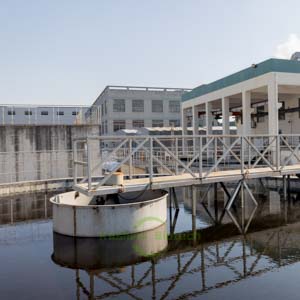

Physical treatment method is to separate and recover insoluble suspended pollutants (including oil film and oil bead) in sewage by physical action, without changing chemical properties in the process of treatment. Commonly used filtration, precipitation, flotation and so on.
(1) Filtration method: use filtration medium to intercept suspended solids in sewage. Filter media including screen, gauze and particles, commonly used filtration equipment including grid, screen, micro filter, etc.
1) Grille and screen. In a drainage project, waste water flows through a sewer to a water treatment plant. First, a set of metal frames (grids), perforated plates or screens (screens) should be made of metal placed diagonally in the channels to prevent floating or suspended objects from passing through and being held back on the grids, fine screens or filter materials.
This step belongs to the pretreatment of wastewater, and its purpose is to recover useful substances; Preliminary flushing wastewater is beneficial to later treatment, reducing the load of sedimentation tank or other treatment equipment; Protect pumping machinery from failure due to particle blockage. Protect pumps and other processing equipment. The effect of fence interception mainly depends on the quality of sewage and the size of fence gap. There are both manual and mechanical methods of dross removal. Slag should be cleaned and treated in time.
Screen mesh is mainly used to intercept small suspended sundry particles between a few millimeters to dozens of millimeters, such as fiber, pulp, algae and so on. , usually made of metal wire and chemical fiber braided or perforated steel plates, with apertures generally less than 5 mm and may be as small as 0.2 mm. Screen filter device includes drum, rotary, rotary plate, fixed vibration inclined screen, etc. Regardless of the structure, it not only intercepts dirt, but also easily offloads and cleans the screen surface.
2) granular media filtration (also known as tong, filter, shock material filtration). When waste water passes through a bed of granular filtering materials (such as quartz sand), fine suspended solids and limbs are trapped in the surface and internal gaps of the filtering material. Commonly used filter media quartz sand, anthracite, garnet and so on. Filtration materials are physically trapped, settled and adsorbed during filtration. The filtration effect depends on the aperture of the filter material, the thickness of the filter material layer, the filtration speed and the nature of the sewage.
When the wastewater flows through the granular filter layer from top to bottom, the suspended particles with large potential diameter are first intercepted in the gap of the surface filter material, which makes the gap of the filter material of the layer smaller and smaller, and gradually forms a filter membrane composed mainly of the intercepted group particles, which plays a major role in filtering. This function belongs to resistance interception or screening function.
When wastewater passes through the filter layer, the surface of many filter materials provides a large effective area for suspended solids to settle, forming numerous small sedimentation ponds where suspended solids settle easily. This action is gravitational sedimentation.
The filter material has a large surface area and has obvious physical adsorption with suspended solids. In addition, sand often with surface negative charge in the water, can absorb positively charged iron, aluminum and other limbs, so as to form a positively charged film on the surface of the filter material, and then adsorb negatively charged colloids and all kinds of organic compounds, and sand contact flocculation.
(2) Precipitation method. Sedimentation method is to use the principle that the relative density of suspended solids and water in sewage is different, and to separate suspended solids from water by gravity sedimentation. According to the concentration and flocculation characteristics of suspended particles in water (i.e. their ability to aggregate with each other), they can be divided into four types:
1) Separate settlement (or free settlement). In the process of precipitation, particles do not converge and precipitate separately. The position is only affected by the gravity in the water and the resistance of the flow, the shape, size and mass remain unchanged, and so does the deceleration.
2) condensation precipitation. Condensation sedimentation refers to the condensation of colloid and small suspended solids in wastewater into separable condensates under the action of coagulants, which are separated and removed by gravity sedimentation. The characteristics of condensation precipitation are that in the process of precipitation, particles gather together to form large flocs due to contact and collision. The size and mass of particles increase with the increase of depth, and the precipitation velocity also increases with the increase of depth.
The commonly used inorganic coagulants are aluminum sulfate, ferrous sulfate, ferric chloride and polyaluminum. The commonly used organic coagulants are polypropylene condensants, etc., and sodium silicate, lime and other coagulants can also be used.
Name: Nicole Yu
Mobile:+86 17718148007
Tel:+86 17718148007
Whatsapp:8617718148007
Email:sales@kashionbiotech.com
Add:No.6, Zhanxi Road, Yaohai District, Hefei City, Anhui Province, China.